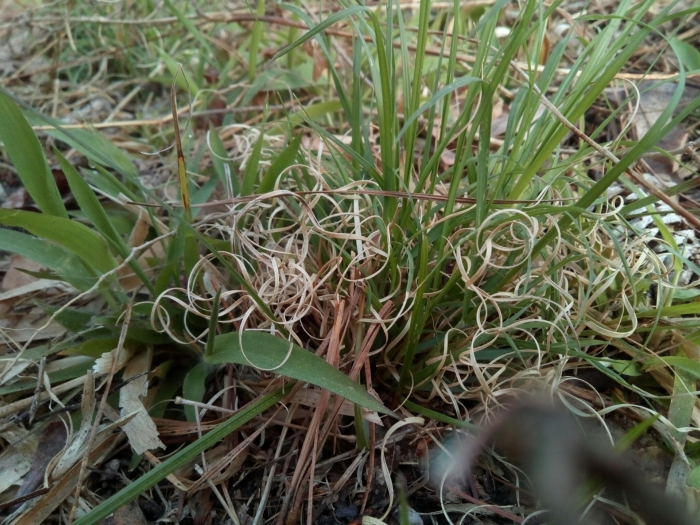Poverty Oatgrass
(Danthonia spicata)
Poverty Oatgrass (Danthonia spicata)
/
/

C.
Public Domain
Image By:
C.
Recorded By:
Copyright:
Public Domain
Copyright Notice:
Photo by: C. | License Type: Public Domain | License URL: http://creativecommons.org/publicdomain/zero/1.0/ | Rights Holder: C. | Publisher: iNaturalist | Date Created: 2018-04-10T08:50:24-07:00 |




















































Estimated Native Range
Summary
Danthonia spicata, commonly known as Poverty Oatgrass, is a deciduous perennial grass native to open woodlands, grasslands, and rocky outcrops in the United States and Canada. It is a bunchgrass that forms a dense tuft of leaves at the base, varying in height from 7 to 100 cm (2.8 to 39 inches). The leaves can be curly, especially in dry conditions, and persist through the winter, providing year-round texture. In moist and shady areas, the leaves tend to be less curly. The inflorescence is a narrow panicle bearing up to 18 spikelets, each with twisted, hairy awns. Additionally, the plant produces cleistogamous florets that do not open but can still self-pollinate. Poverty Oatgrass has a long-lasting soil seed bank, with seeds capable of germinating after many years of dormancy.
This grass is valued for its ability to thrive on poor, dry, and rocky soils, making it a suitable choice for restoration projects and naturalistic plantings. It is often used in meadow gardens, as a ground cover, and in erosion control due to its dense growth habit. Poverty Oatgrass prefers full sun to partial shade and requires medium water, thriving in well-drained soils. It is a low-maintenance plant that can adapt to a range of soil conditions. However, it may not compete well with more aggressive species and can be outcompeted in richer soils.CC BY-SA 4.0
This grass is valued for its ability to thrive on poor, dry, and rocky soils, making it a suitable choice for restoration projects and naturalistic plantings. It is often used in meadow gardens, as a ground cover, and in erosion control due to its dense growth habit. Poverty Oatgrass prefers full sun to partial shade and requires medium water, thriving in well-drained soils. It is a low-maintenance plant that can adapt to a range of soil conditions. However, it may not compete well with more aggressive species and can be outcompeted in richer soils.CC BY-SA 4.0
Plant Description
- Plant Type: Grass
- Height: 0.5-2 feet
- Width: 1-2 feet
- Growth Rate: Moderate
- Flower Color: N/A
- Flowering Season: Summer
- Leaf Retention: Deciduous
Growth Requirements
- Sun: Full Sun, Part Shade
- Water: Medium
- Drainage: Fast
Common Uses
Butterfly Garden, Drought Tolerant, Erosion Control, Groundcover, Low Maintenance
Natural Habitat
native to open woodlands, grasslands, and rocky outcrops in the United States and Canada
Other Names
Common Names: Poverty Oat Grass , Poverty Danthonia , Poverty Grass , Poverty Wild Oatgrass , Danthonie En Épi , Danthonie À Épi
Scientific Names: Danthonia spicata , Danthonia spicata var. pinetorum , Danthonia spicata var. longipila , Danthonia spicata var. spicata , Avena spicata , Danthonia thermale , Avena glumosa , Danthonia spicata var. typica , Danthonia glumosa , Danthonia thermalis
GBIF Accepted Name: Danthonia spicata (L.) Roem. & Schult.